Handsome English actor Ralph Forbes (1904-1951) started his film career in the British cinema before he became a Hollywood star of the 1920s and 1930s. Later he turned into a noted Broadway actor.

British postcard, no. 3932/1. Photo: Metro-Goldwyn-Mayer.

German postcard by Ross Verlag, no. 4142/1, 1929-1930. Photo: Metro-Goldwyn-Mayer. Ralph Forbes and Dolores Del Rio in The Trail of '98 (Clarence Brown, 1928).

German postcard by Ross Verlag, no. 3533/1, 1928-1929. Photo: MGM. Lillian Gish and Ralph Forbes in the American silent film The Enemy (Fred Niblo, 1927).
Ralph Forbes Taylor was born in London, England in 1904 (some sources say 1896). He was the son of E.J. Taylor and actress Mary Forbes and brother of actress Brenda Forbes. He had an accident on the football field at Denstone College, Staffordshire that resulted in a scar on his cheek.
According to William McPeak at IMDb, Forbes had other ideas than the family's wish for him to seek a career in law or the navy. He became interested in acting and began stage work in England. By 1917, he had come to the US to get his feet wet in the film medium with his first silent film that year. But he returned to the UK to work in the early British film industry.
His first British film was the drama The Fifth Form at St. Dominic's (A.E. Coleby, 1921). He then appeared in A Lowland Cinderella (Sidney Morgan, 1922), a modern version of the Cinderella fairy tale with Joan Morgan as the vulnerable Hester Stirling, who must overcome the evil schemes of Dr Torpican to find true love. He then appeared opposite Alma Taylor in the successful romance Comin' Thro the Rye (Cecil M. Hepworth, 1923).
The following year he co-starred with Betty Balfour and Stewart Rome in the war drama Réveille (George Pearson, 1924). In Sweden, he appeared in the comedy Charleys tant/Charley’s Aunt (Elis Ellis, 1926). In 1926, he joined fellow expatriate and A-list star Ronald Colman to play younger brother John in the first Hollywood rendering of Beau Geste (Herbert Brenon, 1926). It became Paramount's biggest hit of 1926.
In the following years, Forbes would work with some familiar names: Lon Chaney in Mr. Wu (William Nigh, 1927), Lillian Gish in The Enemy (Fred Niblo, 1927), Norma Shearer in The Latest from Paris (Sam Wood, 1928), Dolores del Rio in The Trail of '98 (Clarence Brown, 1928), and with John Gilbert in The Masks of the Devil (Victor Sjöström, 1928). Forbes’ handsome features and bright blue eyes gave him an intense look that suited numerous a series of dinner-jacketed leading roles.
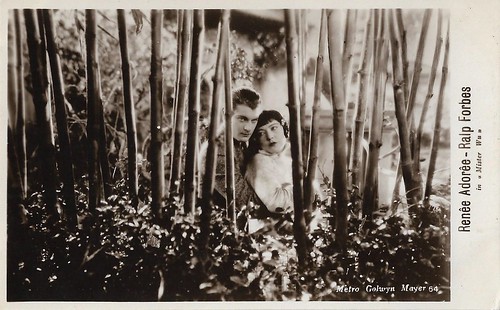
Italian postcard by G.B. Falci, Milano, no. 64. Photo: Metro-Goldwyn-Mayer. Renée Adorée and Ralph Forbes in Mr. Wu (William Nigh, 1927).

Italian postcard by G.B. Falci, Milano, no. 67. Photo: Metro-Goldwyn-Mayer. Renée Adorée and Ralph Forbes in Mr. Wu (William Nigh, 1927). Collection: Marlene Pilaete.
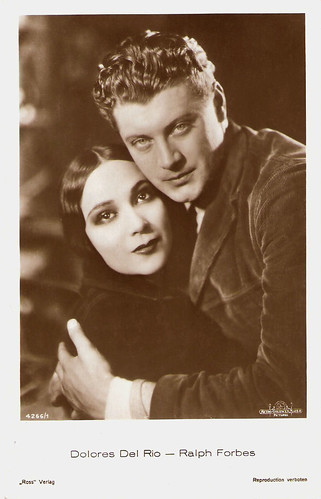
German postcard by Ross Verlag, no. 4266/1, 1929-1930. Photo: Metro-Goldwyn-Mayer. Publicity still for The Trail of '98 (Clarence Brown, 1928) with Dolores Del Rio.
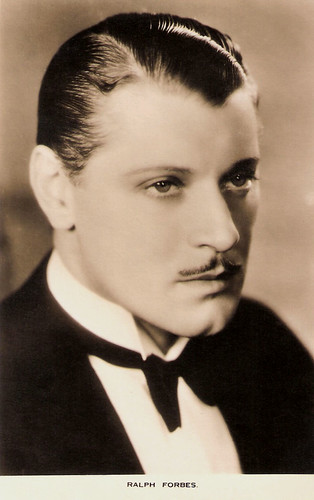
Vintage card.
Ralph Forbes’ rich, full voice made the sound transition a smooth one. The unevenness and muffled nature of early sound movies was apparent in his first effort Lilies of the Field (1930) which was an early American-based effort by Alexander Korda. His six films in 1930 prophesied a busy decade to come. In 1931, he did a sequel to Beau Geste which took up the continuing adventures of the youngest Geste brother John, Beau Ideal (Herbert Brenon, 1931).
In 1933 he co-starred with Katharine Hepburn and Colin Clive in Christopher Strong (Dorothy Arzner, 1933). By then, Forbes was much in demand with five or six movie roles a year through most of the decade. He made the costume rounds: including, the first sound The Three Musketeers (Rowland V. Lee, 1935), Mary of Scotland (John Ford, 1936) starring Katherine Hepburn, and the classic Romeo and Juliet (George Cukor, 1936) in which he played Juliet's suitor Paris.
Forbes was in the sand dunes again for the lead of The Legion of Missing Men (Hamilton MacFadden, 1937). His roles became smaller and his last years before the camera were spent in such supporting roles as Sir Hugo Baskerville in The Hound of the Baskervilles (Sidney Lanfield, 1939) with Richard Greene, and Henry Tudor in Tower of London (Rowland V. Lee, 1939). He was not offered a part in the more famous remake of Beau Geste (William A. Wellman, 1939) with Gary Cooper. Interestingly, this sound version is almost a carbon copy of the 1926 silent effort.
After 1940, Forbes' film work was sporadic. During his last years, he worked on Broadway in such plays as 'The Little Minister' and 'The Doctor's Dilemma'. One of his last stage appearances was in a revival of George Bernard Shaw's 'You Never Can Tell' in 1948. He also did some early TV playhouse productions in 1950 before his untimely passing the next year. Forbes married three times. In 1924 he married his former leading lady Ruth Chatterton, who was 11 years his senior. They divorced in 1932. Forbes dated Lucille Ball, but she turned down his marriage proposal. In 1934 he married actress Heather Angel, but that marriage also ended in divorce. His last wife was actress Dora Sayers, whom he married in 1946. The wedding took place in the home of Ruth Chatterton, his first wife. After an illness of several weeks, Ralph Forbes died at Montefiore Hospital in New York City in 1951.
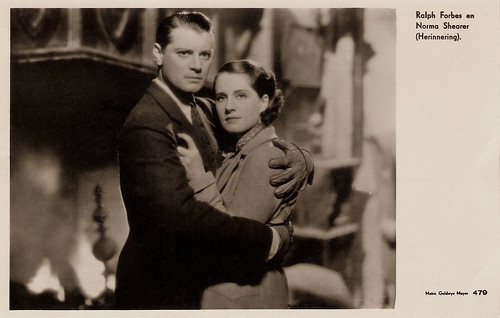
Dutch postcard, no. 479, sent by mail in 1934. Photo: Metro Goldwyn Mayer. Ralph Forbes and Norma Shearer in Smilin' Through (Sidney Franklin, 1932).
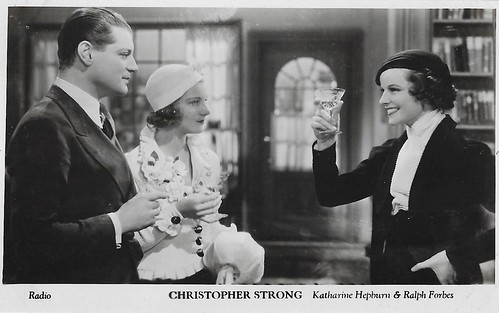
British postcard by Film Weekly. Photo: RKO. Katharine Hepburn in Christopher Strong (Dorothy Arzner, 1933) with Helen Chandler as Strong's daughter Monica and Ralph Forbes as her lover and later on husband, Harry Rawlinson.
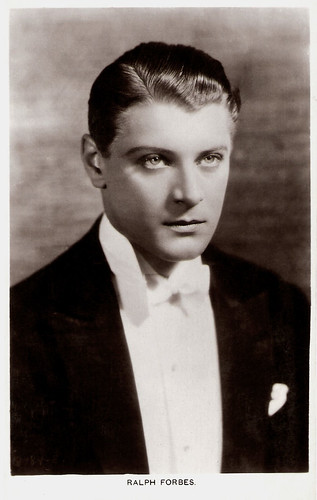
British postcard in the Picturegoer Series, no. 290.
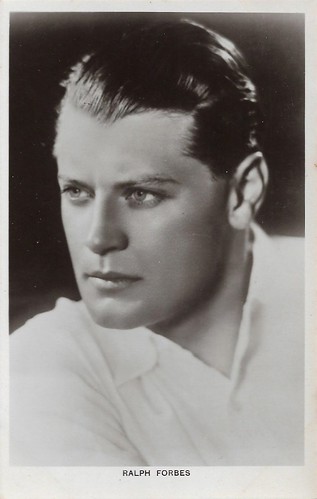
British postcard in the Picturegoer Series, London.
Sources: William McPeak (IMDb), Hal Erickson (AllMovie), Find A Grave, Wikipedia and IMDb.
This post was last updated on 29 March 2024.

British postcard, no. 3932/1. Photo: Metro-Goldwyn-Mayer.

German postcard by Ross Verlag, no. 4142/1, 1929-1930. Photo: Metro-Goldwyn-Mayer. Ralph Forbes and Dolores Del Rio in The Trail of '98 (Clarence Brown, 1928).

German postcard by Ross Verlag, no. 3533/1, 1928-1929. Photo: MGM. Lillian Gish and Ralph Forbes in the American silent film The Enemy (Fred Niblo, 1927).
Paramount's biggest hit of 1926
Ralph Forbes Taylor was born in London, England in 1904 (some sources say 1896). He was the son of E.J. Taylor and actress Mary Forbes and brother of actress Brenda Forbes. He had an accident on the football field at Denstone College, Staffordshire that resulted in a scar on his cheek.
According to William McPeak at IMDb, Forbes had other ideas than the family's wish for him to seek a career in law or the navy. He became interested in acting and began stage work in England. By 1917, he had come to the US to get his feet wet in the film medium with his first silent film that year. But he returned to the UK to work in the early British film industry.
His first British film was the drama The Fifth Form at St. Dominic's (A.E. Coleby, 1921). He then appeared in A Lowland Cinderella (Sidney Morgan, 1922), a modern version of the Cinderella fairy tale with Joan Morgan as the vulnerable Hester Stirling, who must overcome the evil schemes of Dr Torpican to find true love. He then appeared opposite Alma Taylor in the successful romance Comin' Thro the Rye (Cecil M. Hepworth, 1923).
The following year he co-starred with Betty Balfour and Stewart Rome in the war drama Réveille (George Pearson, 1924). In Sweden, he appeared in the comedy Charleys tant/Charley’s Aunt (Elis Ellis, 1926). In 1926, he joined fellow expatriate and A-list star Ronald Colman to play younger brother John in the first Hollywood rendering of Beau Geste (Herbert Brenon, 1926). It became Paramount's biggest hit of 1926.
In the following years, Forbes would work with some familiar names: Lon Chaney in Mr. Wu (William Nigh, 1927), Lillian Gish in The Enemy (Fred Niblo, 1927), Norma Shearer in The Latest from Paris (Sam Wood, 1928), Dolores del Rio in The Trail of '98 (Clarence Brown, 1928), and with John Gilbert in The Masks of the Devil (Victor Sjöström, 1928). Forbes’ handsome features and bright blue eyes gave him an intense look that suited numerous a series of dinner-jacketed leading roles.

Italian postcard by G.B. Falci, Milano, no. 64. Photo: Metro-Goldwyn-Mayer. Renée Adorée and Ralph Forbes in Mr. Wu (William Nigh, 1927).

Italian postcard by G.B. Falci, Milano, no. 67. Photo: Metro-Goldwyn-Mayer. Renée Adorée and Ralph Forbes in Mr. Wu (William Nigh, 1927). Collection: Marlene Pilaete.

German postcard by Ross Verlag, no. 4266/1, 1929-1930. Photo: Metro-Goldwyn-Mayer. Publicity still for The Trail of '98 (Clarence Brown, 1928) with Dolores Del Rio.

Vintage card.
A busy decade
Ralph Forbes’ rich, full voice made the sound transition a smooth one. The unevenness and muffled nature of early sound movies was apparent in his first effort Lilies of the Field (1930) which was an early American-based effort by Alexander Korda. His six films in 1930 prophesied a busy decade to come. In 1931, he did a sequel to Beau Geste which took up the continuing adventures of the youngest Geste brother John, Beau Ideal (Herbert Brenon, 1931).
In 1933 he co-starred with Katharine Hepburn and Colin Clive in Christopher Strong (Dorothy Arzner, 1933). By then, Forbes was much in demand with five or six movie roles a year through most of the decade. He made the costume rounds: including, the first sound The Three Musketeers (Rowland V. Lee, 1935), Mary of Scotland (John Ford, 1936) starring Katherine Hepburn, and the classic Romeo and Juliet (George Cukor, 1936) in which he played Juliet's suitor Paris.
Forbes was in the sand dunes again for the lead of The Legion of Missing Men (Hamilton MacFadden, 1937). His roles became smaller and his last years before the camera were spent in such supporting roles as Sir Hugo Baskerville in The Hound of the Baskervilles (Sidney Lanfield, 1939) with Richard Greene, and Henry Tudor in Tower of London (Rowland V. Lee, 1939). He was not offered a part in the more famous remake of Beau Geste (William A. Wellman, 1939) with Gary Cooper. Interestingly, this sound version is almost a carbon copy of the 1926 silent effort.
After 1940, Forbes' film work was sporadic. During his last years, he worked on Broadway in such plays as 'The Little Minister' and 'The Doctor's Dilemma'. One of his last stage appearances was in a revival of George Bernard Shaw's 'You Never Can Tell' in 1948. He also did some early TV playhouse productions in 1950 before his untimely passing the next year. Forbes married three times. In 1924 he married his former leading lady Ruth Chatterton, who was 11 years his senior. They divorced in 1932. Forbes dated Lucille Ball, but she turned down his marriage proposal. In 1934 he married actress Heather Angel, but that marriage also ended in divorce. His last wife was actress Dora Sayers, whom he married in 1946. The wedding took place in the home of Ruth Chatterton, his first wife. After an illness of several weeks, Ralph Forbes died at Montefiore Hospital in New York City in 1951.

Dutch postcard, no. 479, sent by mail in 1934. Photo: Metro Goldwyn Mayer. Ralph Forbes and Norma Shearer in Smilin' Through (Sidney Franklin, 1932).

British postcard by Film Weekly. Photo: RKO. Katharine Hepburn in Christopher Strong (Dorothy Arzner, 1933) with Helen Chandler as Strong's daughter Monica and Ralph Forbes as her lover and later on husband, Harry Rawlinson.

British postcard in the Picturegoer Series, no. 290.

British postcard in the Picturegoer Series, London.
Sources: William McPeak (IMDb), Hal Erickson (AllMovie), Find A Grave, Wikipedia and IMDb.
This post was last updated on 29 March 2024.
No comments:
Post a Comment